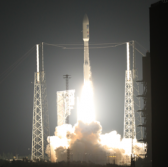 Lockheed Martin will begin environmental and mechanical tests on a satellite that the National Oceanic and Atmospheric Administration will use to support U.S. weather observation operations.
Lockheed Martin will begin environmental and mechanical tests on a satellite that the National Oceanic and Atmospheric Administration will use to support U.S. weather observation operations.
Lockheed said Tuesday the Geostationary Operational Environmental Satellites – S weather satellite is the second of four GOES-R series geostationary weather satellites and will undergo tests that simulate launch and extreme space environments.
“This period validates the satellite’s overall design, assembly workmanship, and survivability during launch and on-orbit operation in the cold vacuum of space,” said Tim Gasparrini, vice president and GOES-R series program manager at Lockheed’s space systems business.
The GOES-S satellite will undergo various operational checks such as deployment of solar arrays and antennas, shock tests, thermal vacuum tests, electromagnetic interference and compatibility tests, Lockheed noted.
The company added the satellite recently completed reverberant acoustics and sine vibration tests in efforts to expose the satellite to sound and vibrations experienced during launch aboard a United Launch Alliance-built Atlas V 541 rocket.
GOES-R launched Nov. 19 and entered into geostationary orbit, where the satellite now designated GOES-16 is undergoing post-launch and checkout test activities.




